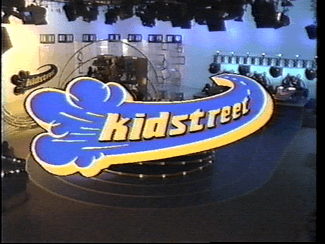Kidstreet facts for kids
Quick facts for kids Kidstreet |
|
|---|---|
 |
|
| Created by | Blair Murdoch |
| Directed by | Stan Litke (1987-1991) Dave Stewart (1991-1992) |
| Presented by | Kevin Frank |
| Narrated by | Kathy Morse |
| Theme music composer | Kathy Morse Garnet Morse |
| Country of origin | Canada |
| No. of seasons | 5 |
| No. of episodes | 350 |
| Production | |
| Executive producer(s) | Blair Murdoch |
| Producer(s) | Blair Murdoch Deborah Sanderson |
| Production location(s) | CFAC-TV, Calgary, Alberta (1987-1991) CKVU-TV, Vancouver, British Columbia (1991-1992) |
| Camera setup | Multi-camera |
| Running time | 30 minutes |
| Production company(s) | Northstar Syndications Inc. (1987-1989) Blair Murdoch Television Inc. (1989-1992) |
| Distributor | National T-Vision Marketing (1990–1991) |
| Release | |
| Original network | Global |
| Picture format | SDTV |
| Audio format | Stereo |
| Original release | 1987 – 1992 |
Kidstreet was a fun Canadian game show for kids. It was on TV from 1987 to 1992. Kevin Frank was the host. Kathy Morse was the announcer, which was pretty cool because not many women were announcers back then!
Blair Murdoch created the show. It was first made in Calgary, Alberta. You could watch it on Global and WIC in Canada. Later, old episodes were shown in the United States on America One. For its last year, the show moved to Vancouver, British Columbia. Kidstreet was a very popular show for Blair Murdoch, lasting five seasons!
Contents
How the Game Was Played
In Kidstreet, three teams of two kids played. All the kids on a team were siblings. They sat in cool race cars on the set. The goal was to see how well they knew each other. If they matched answers, they won points and prizes!
A special thing about the show was the "overhead clapping." When teams got a correct answer, everyone clapped above their heads. Host Kevin Frank later shared why this started. A sound person was upset that normal clapping messed up the sound. So, he told everyone to clap above their heads instead!
The Main Game Rounds
The game had three main rounds, called "laps." Teams tried to earn points by matching answers.
Lap 1: Drivers and Passengers
In the first lap, one sibling from each team was called the "driver." They left the stage. Their sibling, the "passenger," stayed and answered two or three questions. These questions were about their driver sibling. The host, Kevin Frank, asked them.
The passenger's answers were like predictions. When the drivers came back, they were asked the same questions. If a driver's answer matched their passenger's answer, the team earned 1 point! Points were shown on special displays behind the cars. After this round, Kevin Frank would chat with the teams.
Lap 2: Switching Roles
This lap was like the first one, but with a twist! The "drivers" from Lap 1 became the "passengers." The "passengers" from Lap 1 became the "drivers." They switched roles.
The questions were asked again, but this time, each correct match was worth 3 points! This made the game more exciting.
The Final Lap: Winning the Game
The final lap was the big one! The roles went back to how they were in Lap 1. The passengers answered one last question. If the drivers matched their answers, the team earned 5 points!
The team with the most points at the end of this lap won the game! A perfect score, meaning all answers matched, was 17 points. The teams that didn't win still got cool gifts. These included Kidstreet t-shirts, sneakers, watches, gift cards, and a goodie bag with treats like Coca-Cola. They even got a home game version of Kidstreet!
The Kidstreet Rebus Bonus Game
The winning team got to play a bonus puzzle called the "Kidstreet Rebus." This was like the game show Concentration. They saw a grid with 25 numbered squares.
Some squares were already revealed at the start. The number of squares shown depended on how many points the team scored in the main game. If a team got a perfect score of 17 points, all 25 squares were revealed!
Then, the team chose five more squares to reveal. They had 20 seconds to solve the puzzle. A "gas gauge" on the screen showed the time ticking down. If they solved it in time, they won a big grand prize!
If they didn't solve it, they got 10 more seconds. The audience could even help them this time! If they solved it then, the clock stopped. They won up to 10 smaller prizes, depending on how much time was left.
After the Rebus, the winners got to grab prizes from a huge pile of toys! This pile often had teddy bears, toy cars, and other fun items. It was usually sponsored by Toys and Wheels.

